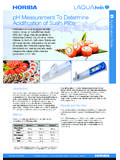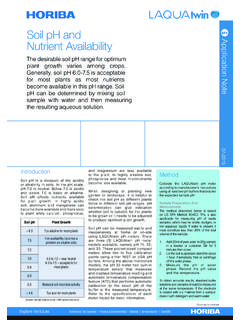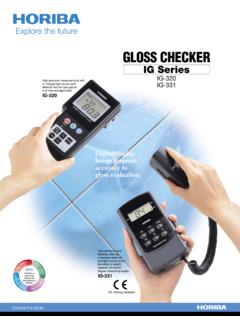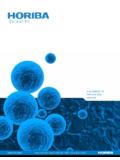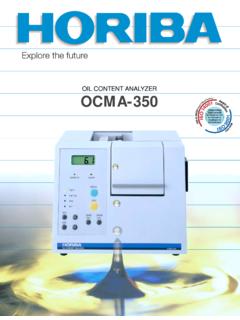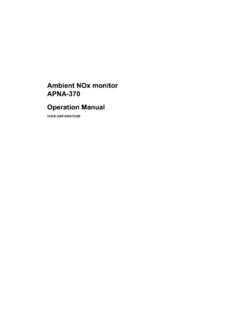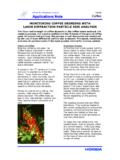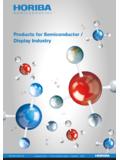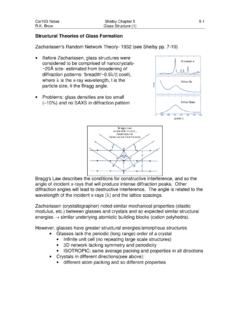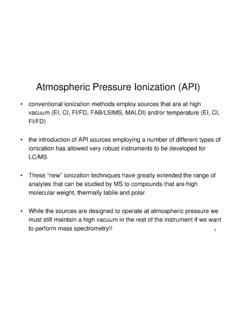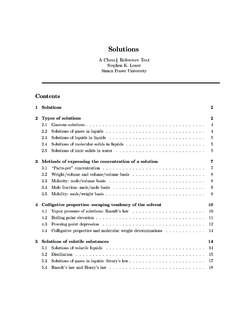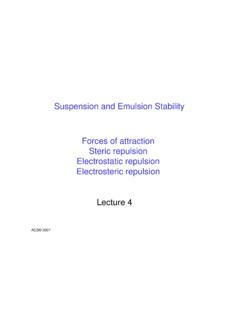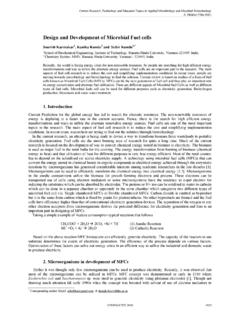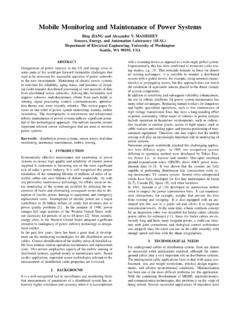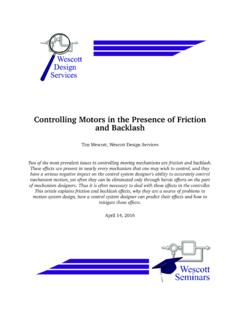Transcription of Time resolved fluorescence lifetime measurements …
1 time resolved fluorescence Technical Note TRFT 1 time resolved fluorescence lifetime measurements The radiative emission of light from a molecule after excitation has a multiparameter nature. The objective of a measurement is therefore to gain information concerning as many parameters as possible. A steady state measurement of the fluorescence emission (intensity vs wavelength) gives an average and also relative representation. The fluorescence lifetime gives an absolute (independent of concentration) measure and allows a dynamic picture of the fluorescence to be obtained, factors that explain the appeal of this form of measurement . The fluorescence decay The decay of the excited state of a molecule to the ground state can be expressed as; )/exp()(0 tItI where, I0 is the intensity at time zero (upon excitation) and is the lifetime .
2 This is defined as the time for the intensity to drop by 1/e or to 37%. In terms of rate constants (kr radiative rate, knr non radiative rate) the lifetime can be written as below, which can be compared to the fluorescence quantum yield ( ) nrrkk 1 , nrrrkkk The fluorescence (FL) signal is multiparametric and can be considered as follows, along with the measurements that can elucidate them, ),,,,,(txpIfFLemexc where; I= intensity measurement is quantum yield ( ), exc= excitation wavelength measurement of absorption spectrum, em= emission wavelength measurement of fluorescence spectrum, p = polarisation measurement of anisotropy, x= position measurement by fluorescence microscopy, t= time measurement of fluorescence lifetime . Although the decay law is based on first order kinetics, in practice, many fluorescence decays are more complex.
3 Often populations of excited molecules are in an inhomogeneous environment and quenching processes and other environmental influences can lead to multi or non exponential decay behaviour. One of the major advantages of using the fluorescence lifetime is the fact that it is an absolute measurement , unlike the steady state intensity, which is relative. The fluorescence lifetime is an intrinsic molecular property and, within certain constraints, independent of concentration. This means that changes in concentration, whether caused by photobleaching or diluting/ concentrating the sample, would not affect the lifetime value. This is in contrast to a steady state measurement , where a change in intensity of the recorded emission would be observed. Furthermore using time correlated single photon counting (TCSPC), the lifetime is not influenced by fluctuations in excitation source intensity.
4 The implication is that a measurement taken on one piece of equipment at a certain time and place should be capable of being repeated later elsewhere (provided the sample is stable and measurement conditions are preserved). fluorescence is an ideal nanoscale probe, as the fluorescence decay take places on the nanosecond timescale and it can be influenced by molecular processes occurring on the nanometre range. The emission of a fluorophore can be highly influenced by its environment or the presence of other interacting molecules, which can affect knr. Thus the fluorescence lifetime is useful in elucidating; changes in the nanoenvironment o viscosity, pH, polarity, solvation size and shape of molecules molecular interactions time resolved fluorescence Technical Note TRFT 1 inter and intramolecular distances kinetic and dynamic rates resolution of molecular mixtures The extra specificity of the fluorescence lifetime allows easy discrimination against scattered excitation and background fluorescence .
5 Determination of F rster resonance energy transfer (FRET) is much simpler using the fluorescence lifetime , as are quenching and fluorescence anisotropy measurements , allowing more parameters to be recovered. However, it should be remembered that the use of steady state and time resolved techniques are complementary in elucidating as much of the multiparametric fluorescence signature as possible. time correlated single photon counting (TCSPC) This is considered the most sensitive method for determining fluorescence lifetimes. It is a digital technique, with well defined (Poisson) statistics, which is not affected by changes in source intensity, unlike some analogue measurement techniques. TCSPC is based on the detection of the arrival times of individual photons after optical excitation of a sample. It makes use of a pulsed excitation source (typically laser or LED), as shown schematically in Fig.
6 1. Production of a light pulse starts the timing electronics. These are stopped by a signal from the detector, triggered when a fluorescence photon hits the detector. The difference in time between these two signals is then outputted to a histogram, consisting of time bins, with fixed time width ( t). So signals arriving within t+ t go into one specific bin. The width of the bins will also influence the time resolution of the system. The excitation emission process is repeated many times (usually to 10,000 counts in the peak channel). This builds up a histogram of number of events (counts) versus time . However, for the histogram to be representative of the decay ( the number of counts at a certain time after excitation to be equivalent to the intensity at that time ) a certain condition needs to be observed. This is that only one photon can be counted at any one time , so it is required statistically to count only one photon and for it not to arrive during the dead time of the timing electronics.
7 In practical terms the stop count rate needs to be limited to ca. 2% of the excitation rate. Failure to do so can lead to a biasing towards detection of photons arriving at shorter times, a phenomenon known as pulse pile up. This apparent inefficiency of the TCSPC technique is usually not considered a problem as the excitation rate can be in the MHz range, enabling acquisitions under a second to be made. Historically using lower repetition rate sources led to longer data acquisition times. Fig. 1. Schematic for TCSPC When measuring longer lived decays, re excitation of the sample before it has fully decayed should be avoided, thus the excitation rate should be set to less than 1/( time range). time ranges are normally selected to be 10 to 20 times that of the lifetime to be measured. This restriction on the maximum excitation rate and hence data collection rate, means that the measurement of longer lived decays can be quite time consuming on time to amplitude converter (TAC) based systems.
8 Normally a different approach is used when measuring decays on the phosphorescence ( s) timescale to overcome this restriction and reduce the data collection time . Typical components and TCSPC system response The scheme shown in Fig. 1 is obviously very general. The pulsed source is usually a solid state LED or laser, although pulsed supercontinuum or femtosecond lasers can also be used. Since fluorescence occurs at longer wavelengths some form of wavelength discrimination, such as filters or monochromator is employed to select the desired fluorescence emission. The type of detector used is highly dependent on the required wavelength and time resolution. It often requires an additional amplifier, along with a discriminator. Sometimes all these components are available in one module. The timing device should have a low dead time to efficiently record all photon events, low timing jitter, a small time channel width and a reasonable number of channels in the histogram.
9 Typically the number of histogram channels is ~4k. The timing electronics may be a card in a computer or a stand alone device. The latter is advantageous startstopsourcedetectorsampletime digitisertimenumbertime bins xxxxxxxxxxxxxxxxxxxxxxxxxxxxxxxxxxanalys is time resolved fluorescence Technical Note TRFT 1 as it avoids the electronically noisy environment of the computer and obsolescence of computer hardware. Ideally the light exciting the sample should be a delta function (intensity with no temporal width) and the detector should instantaneously transform an incident photon into an electrical output. In reality each component has a response time . This means that the excitation source response, usually indicated by its temporal full width at half maximum intensity (FWHM), is a factor along with timing electronics jitter.
10 Another advantage of TCSPC is that only the transit time spread (TTS) of the detector, rather than the overall response time , needs to be considered. Note that, the TTS is often much shorter than the detector response time . An estimate of the system response broadening caused by these factors is given by the following formula, 21222det2 iielectexcmttttt Where, tm is the measured response, the subscripts exc, det and elect refer to the excitation source, detector and timing electronics respectively. Other factors (subscript i) can also be present, but generally uncertainty in the measured response is dominated by that of the source and detector. Since the system response is not a delta function response, the measured decay can also be distorted by these instrumental factors and it may be thought that it would not be possible to recover lifetime values less than the measured response.
